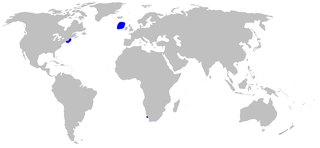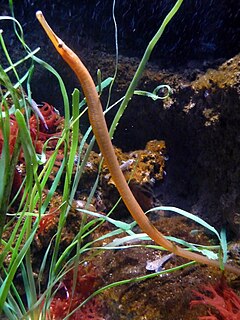
The yacare caiman, also known commonly as the jacare caiman, Spanish yacaré, Paraguayan caiman, piranha caiman, red caiman, southern spectacled caiman, jacaré in Portuguese, and îakaré in Old Tupi, is a species of caiman, a crocodilian in the family Alligatoridae. The species is endemic to Argentina, Bolivia, Brazil, and Paraguay. Brown in color and covered with dark blotches, males grow to a total length of 2–3 m (6.6–9.8 ft) and females to 1.4 m (4.6 ft). Typical habitats of this caiman include lakes, rivers, and wetlands. Its diet primarily consists of aquatic animals, such as snails, and occasionally land vertebrates. Mating occurs in the rainy season and eggs hatch in March, with young fending for themselves as soon as they hatch. The yacare caiman was hunted heavily for its skin to use for leather in the 1980s, which caused its population to decrease significantly. However, trading restrictions placed since have caused its population to increase. Its population in the Pantanal is about 10 million, and it is listed as least concern on the IUCN Red List.

The bay duiker, also known as the black-striped duiker and the black-backed duiker, is a forest-dwelling duiker native to western and southern Africa. It was first described by British zoologist John Edward Gray in 1846. Two subspecies are identified. The bay duiker is reddish-brown and has a moderate size. Both sexes reach 44–49 cm (17–19 in) at the shoulder. The sexes do not vary considerably in their weights, either; the typical weight range for this duiker is 18–23 kg (40–51 lb). Both sexes have a pair of spiky horns, measuring 5–8 cm (2.0–3.1 in). A notable feature of this duiker is the well-pronounced solid stripe of black extending from the back of the head to the tail.

The flathead grey mullet is an important food fish species in the mullet family Mugilidae. It is found in coastal tropical and subtropical waters worldwide. Its length is typically 30 to 75 centimetres. It is known with numerous English names, including the flathead mullet, striped mullet, black mullet, bully mullet, common mullet, grey mullet, sea mullet and mullet, among others.
Britski's catfish is a tropical freshwater fish belonging to the subfamily Corydoradinae of the family Callichthyidae native to South America where it is found in the upper Paraguay River basin in Brazil. This species was formerly classified as Brochis britskii.

The ghost catshark is a catshark of the family Scyliorhinidae found on the continental slopes in the northwest Atlantic off Massachusetts, the northeast Atlantic from the Porcupine Bank west of Ireland and the southern Atlantic off Cape Town, at depths between 600 and 1,900 metres.

The snakeskin gourami is a species of gourami native to Southeast Asia. Prior to the merging of Belontidae to the family Osphronemidae, the snakeskin gourami was regarded as the largest member of its family. It is still the largest species in its genus and subfamily.

Lithodoras dorsalis, the rock-bacu, is the only species in the genus Lithodoras of the catfish family Doradidae. This species originates from the Amazon basin in Brazil and estuaries near Cayenne, French Guiana. These fish feed on the leaves of macrophytes. When the forests are flooded, they feed exclusively on fruits and seeds, acting as an agent of seed dispersal. Reproduction occurs once a year and juveniles are often seen in large numbers in the estuary of the Amazon. These fish reach a length of 100 centimetres (39 in) TL and a weight of up to 15 kilograms (33 lb).

The yellow-edged lyretail also known as the yellowedge coronation trout, fairy cod, lunar tail rock cod, lunartailed cod, lyre-tail cod or moontail seabass,, is a species of marine ray-finned fish, a grouper from the subfamily Epinephelinae which is part of the family Serranidae, which also includes the anthias and sea basses. It is found in the Indo-Pacific region and is more common than the congeneric white-edged lyretail.

The Kessler's gudgeon is a European species of freshwater fish in the family Cyprinidae. It is found in the Danube and Vistula drainage basins, including parts of Poland, Austria, the Czech Republic, Ukraine, Bulgaria, Romania, Moldova, Hungary, Croatia, Bosnia and Herzegovina, Serbia, Montenegro, Slovakia, and Slovenia. It is a small fish of no economic or sporting importance. It was at one time classified as Gobio kessleri.

Triplophysa is a genus of fish in the family Nemacheilidae found mainly in and around the Qinghai-Tibet Plateau in China. Currently, the genus is a mixed assemblage of species. Some lineages have been identified and treated as subgenera, but as Wikipedia follows Fishbase for fish species all but Hedinichthys have been treated as subgenera in Wikipedia, although Kottelat in his revision of the loaches did recognise them as valid. FishBase, however, includes these in Triplophysa without specifying subgenera and treats the names given by Kottelat as synonyms.
The carpenter's chimaera, also known as the giant chimaera or the giant purple chimaera, is a species of fish in the family Chimaeridae.

Cephalopholis fulva, the coney or the butterfish, is a species of marine ray-finned fish, a grouper from the subfamily Epinephelinae which is in the family Serranidae which also includes the anthias and sea basses. It is found in the western Atlantic. It is associated with reefs and is a quarry species for commercial and recreational fisheries. It can be found in the aquarium trade.
Triplophysa grahami is a small species of stone loach from China. It is endemic to the Jinsha River basin in Yunnan, Southwest China. There is also a record from Lishe River, but this is believed to be a different species. It grows to 9.1 cm (3.6 in) standard length. It lives in the spaces between stones and floating grasses in slow streams.

Triplophysa intermedia is a species of ray-finned fish in the genus Triplophysa. The species has only been found in Hulun Lake in Inner Mongolia, China; but is believed to appear in other locations as well since fish in this genus are typically found in running water.
Triplophysa longipectoralis is a cave-living species of stone loach with vestigial eyes. The fish lives in clear water at temperatures below 20 °C. The holotype was caught in Xunle town, Huanjiang Maonan Autonomous County in the Liu River basin, Guangxi, China and was described by Zheng et al. in 2009.
Triplophysa stenura is a species of ray-finned fish in the genus Triplophysa. It lives in swift-flowing streams and is known from the Upper Yangtze, Upper Mekong, Upper Salween and Upper Brahmaputra river drainages in China and Vietnam. Whether this apparently widespread species really is one species needs to be studied. It grows to 13.8 cm (5.4 in) SL.
Muraenoclinus dorsalis, the nosestripe klipfish, is a species of clinid native to the Atlantic coast of southern Africa from Namibia to Natal, South Africa where it can be found in stony tide pools. It is viviparous. This species can reach a maximum length of 10 centimetres (3.9 in) TL. It is currently the only known member of its genus.

Agonus cataphractus, commonly known as the hooknose, pogge or armed bullhead, is a species of fish in the family Agonidae, close to the scorpion fish. It is the only species of the genus Agonus.

The snake pipefish is a species of pipefish, from the family Syngnathidae, native to the northeastern Atlantic Ocean where they are generally found amongst algae close in to shore. It is the largest species of pipefish recorded in European waters and has spread into arctic waters in the early 2000s.

The common shore eel is a species of clingfish from Australia. It is generally found in the south-eastern waters of Australia. It usually grows to about 12 cms. Often found by beachgoers after looking in rock-pools and turning over shells.













